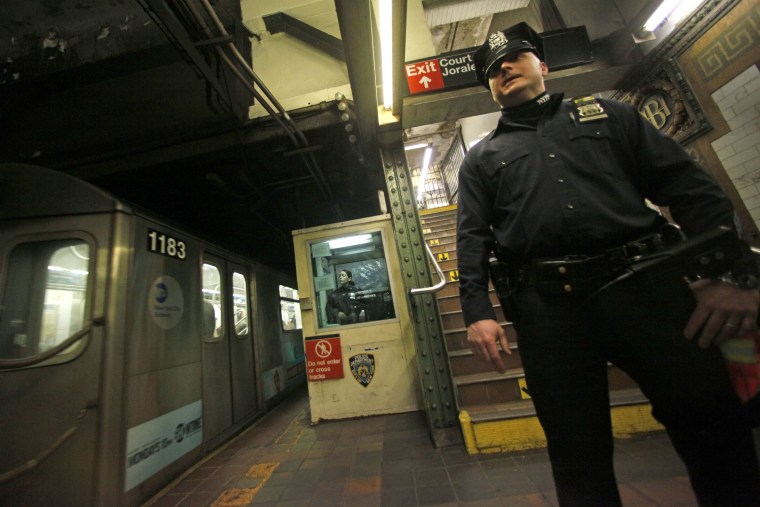The tidy, three-story brownstone looks like any other on the cobblestone block in Brooklyn, but it isn't. It's a fake, leading directly to the belly of the nation's largest subway system.
The unmarked emergency exit behind the facade is one of many posts protected by beat cops defending the city against bombings or other terror attacks in the city's intricate underground mass transit network.
Since the Sept. 11, 2001, attacks, officials at the nation's largest police department insist the city remains the nation's No. 1 terror target, devoting extra resources to protecting Wall Street, the Empire State Building, Brooklyn Bridge and other high-profile potential targets.
But perhaps the biggest worry — spurred by the recent bombing in Moscow and a foiled plot in New York — is the subway, a porous, 24-hour-a-day system with 468 stations and an average of 5 million riders a day.
Authorities have employed bomb-sniffing dogs, high-tech explosive detection devices and security cameras to protect the sprawling subway system. And they've hired Robert McMillan, a third-generation NYPD transit officer who wears a shield bearing the same number as his grandfather's.
"It's important to have presence here," the 36-year-old McMillan said toward the end of a recent shift guarding the dimly lit subway tunnels that run beneath the East River.
The NYPD's counterterrorism division has sought to defend the subway by studying mass transit attacks in Madrid, London, Bombay and, most recently, Moscow to learn about the latest terror tactics.
Always ready to adjust
Within hours of the Moscow suicide bombings, the department took the precaution of beefing up security at key transportation hubs throughout the city.
"We look at how the devices were brought in," said Inspector Martin Conway, counterterrorism coordinator for the NYPD's transit bureau. "Was it liquid explosives? Remote detonation, with maybe a cell phone? A male suicide bomber? Female? ... Anything that would give us some intelligence so we can adjust."
Among the adjustments the NYPD has made in recent years:
- Deploying roving teams of officers with heavy arms and dogs to sweep subway stations and trains;
- Outfitting officers with pager-size radiation detectors to guard against a 'dirty bomb' nuclear device;
- Conducting tens of thousands of random bag searches each year;
- Training officers in "hostile surveillance detection" — the ability to spot suspects casing the subway system.
"Few elements of urban infrastructure are more essential than the subways," Police Commissioner Raymond Kelly said at a recent security briefing. "Protecting them is one of our top priorities and our greatest challenges."
One stark reminder of that challenge came in February with the guilty plea of Najibullah Zazi, a former airport shuttle driver accused of plotting a suicide bomb attack on the city. Zazi told a judge his plan was "to conduct a martyrdom operation on the subway lines in Manhattan as soon as the material was ready."
14 tunnels to watch
At the heart of the underground counterterrorism effort are transit officers like McMillan, who watch over 14 subway tunnels for signs of suspicious activity.
The officers work four-hour shifts on overtime, standing post in tiny guard booths that the NYPD erected on subway platforms after the Sept. 11 attacks. The booths, at the openings of the tunnels, are plastered with subway maps and have monitors fed by security cameras showing inside the tunnels.
Each hour, the officers board subway trains and ride in front with the driver. Using a flashlight, they scan the tracks "for anything that's not normal," McMillan, a 16-year veteran, said while riding a No. 4 train from Brooklyn to Lower Manhattan.
If they spot a suspicious bag or package, they report it to their superiors — but never on a police radio, out of fear that a transmission could set off a remote-control explosive.
The officers also receive the same training as subway workers on how to walk through the tunnels and avoid numerous hazards. Because of that, they've become familiar with a subway oddity: the town house emergency exit.
The NYPD allowed The Associated Press to visit the hidden exit — fronted by the phony house in a quiet residential neighborhood — on condition its origins and location not be disclosed. The department also barred photos.
Located in the tunnel just east of the river, the exit leads to a grimy lit set of metal stairs that ascend past utility boxes and ventilation shafts into a bleak, windowless room with a door. Anyone opening the door would find themselves on a stoop — part of the facade replicating a town house.
The passageway once was only secured from the outside by a giant bolt in the middle of the door that was opened with a tire iron. It's now rigged with silent alarms and motion detectors that would alert police to an intruder.
The security reflects concerns that a terrorist could use the passageway to sneak into the system, or try to tamper with the ventilation to make a chemical or biological attack more lethal.
The subterranean detail, while considered vital, can be tedious — and thankless. Last month, a local television station broadcast footage of an officer dozing off in a booth in Grand Central Terminal.
"It's a tough assignment," Inspector Conway said. "It's boring. It's not romantic. ... But it's still very important. We count on those officers."
